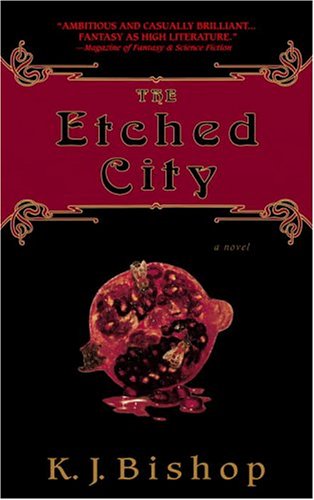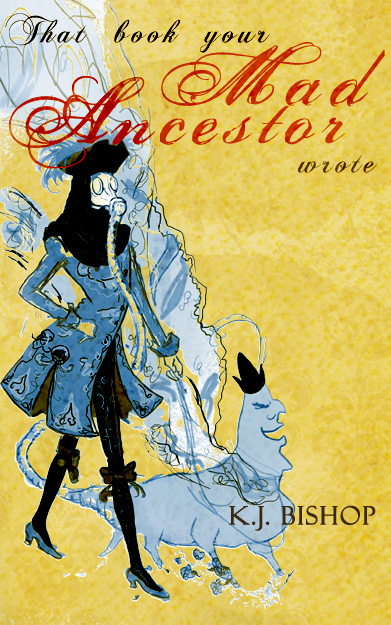K.J. Bishop’s 2003 debut The Etched City launched to an insane amount of praise from some of fantasy’s most prestigious authors and was nominated for a World Fantasy Award. A decadent novel in the literal and literary sense, tinged with weird Western tropes, Bishop crafted a new world peopled with gunslingers, mad scientists, and exotic monsters. But none of the colorful killers residing in the city of Ashamoil—Bishop’s New Crobuzon, her Amber—were as dangerous as an artist shaping reality from dreams.
That Book Your Mad Ancestor Wrote, a collection of nineteen stories spanning the Australian writer’s career from her earliest sales to works published here for the first time, is a menagerie of marvels. (And at the time of this writing, it just won the Aurealis Award for Best Collection.) The prose is atmospheric, wry, and challenging. Fans of unconventional fantasy will be pleased if they are willing to trust in Bishop’s authorial vision and follow it down some very surreal avenues.
Perhaps “The Love of Beauty,” which you can read for free online at the Weird Fiction Review, is the most traditional fantasy story in the bunch, a riff on “Beauty and the Beast” that is darkly erotic and largely about the transformative power of art.
I read That Book Your Mad Ancestor Wrote as much in one go as I was able and was struck by how many of these stories, written years apart, echoed sentiments, imagery, and even different facets of the same characters. Bishop has a rich internal mythology, inhabited by avatars representing the most mysterious aspects of human consciousness. But the gallery of witches, murderers and magicians, while nightmarish, are not without wit.
 The central figure of many of the stories is a shadowy assassin who goes by several names. Sometimes he is the dangerous aesthete Gwynn, the main protagonist of The Etched City, seen here in two stories that serve as epilogues. “She Mirrors” is a particularly enjoyable study of a criminal in his sunset years, haunted by an old love. The Marquis (already evocative of de Sade) also makes two appearances: as a character in “Madame Lenora’s Rings” and as the guest of honor at a bizarre funeral procession. The latter episode in “Two Dreams” does seem to be transcribed directly from the author’s dream, strange twists of logic and intuition included.
The central figure of many of the stories is a shadowy assassin who goes by several names. Sometimes he is the dangerous aesthete Gwynn, the main protagonist of The Etched City, seen here in two stories that serve as epilogues. “She Mirrors” is a particularly enjoyable study of a criminal in his sunset years, haunted by an old love. The Marquis (already evocative of de Sade) also makes two appearances: as a character in “Madame Lenora’s Rings” and as the guest of honor at a bizarre funeral procession. The latter episode in “Two Dreams” does seem to be transcribed directly from the author’s dream, strange twists of logic and intuition included.
The title character of “Maldoror Abroad” is also kin to Gwynn and The Marquis, though much more purely evil. Based on the prose-poem by the Comte de Lautréamont, Maldoror grips you with his elegant voice and forces you to bear witness to a succession of increasingly surreal horrors. Most unsettling of all is his mere presence that infects the land around him like a disease: “Don’t look for me among the famous villains, but Second Ruffian might be wearing my face,” he demurs. I’m also pretty sure there’s a Deadwood joke in the story. I think this was definitely one of the standout stories of the collection.
While most of the stories are creepy, most are also beautiful and touching. “Saving the Gleeful Horse” is about a giant taking care of an injured animal and the lengths he’ll go to save the life of his only companion. “The Memorial Page” is a cool, short fable about a lost city and “Alsiso,” while not very sweet, is about a lost word. The shifts in the meaning of Alsiso (a typo that inspired a full anthology, actually) grow and grow until it reaches cataclysmic proportions. Many of the characters within Bishop’s stories are trying to convince themselves of a truth, whether it’s a young Australian girl who believes she has seen a UFO (“Vision Splendid”) or a giant mouse-man who is trying to teach his simple gopher-creature son to live by a samurai code (“The Heart of a Mouse.”)
I love author’s notes in story collections and the one that closes out Mad Ancestor provides further insight to the preceding tales. Many were written to strange prompts, a challenge Bishop rises to. Inspiration comes from these unlikely jumble of words as often as it does from other writers, such as M. John Harrison, Jorge Luis Borges, Sappho. One of the best and easiest to interpret as deeply personal stories, “Between the Covers” is a Faustian tale of an author, like Bishop herself, struggling to write a second novel after a successful debut.
It’s no coincidence that Ann and Jeff Vandermeer picked a Bishop story to close their epic 2011 collection The Weird; Bishop’s surrealist voice comes from a classic literary tradition transformed into something joyously disorientating. That Book Your Mad Ancestor Wrote, thus, isn’t wholly for every taste. But the broad scope of stories, lush prose, and moments of pure awe coalesces into a handsome volume of genre-bending fantasy perfect for readers in want of fresh ideas.
That Book Your Mad Ancestor Wrote is self-published. For more information, visit K.J. Bishop’s official site.
Theresa DeLucci is a regular contributor to Tor.com, covering True Blood, Game of Thrones, and gaming news. Follow her on Twitter @tdelucci










